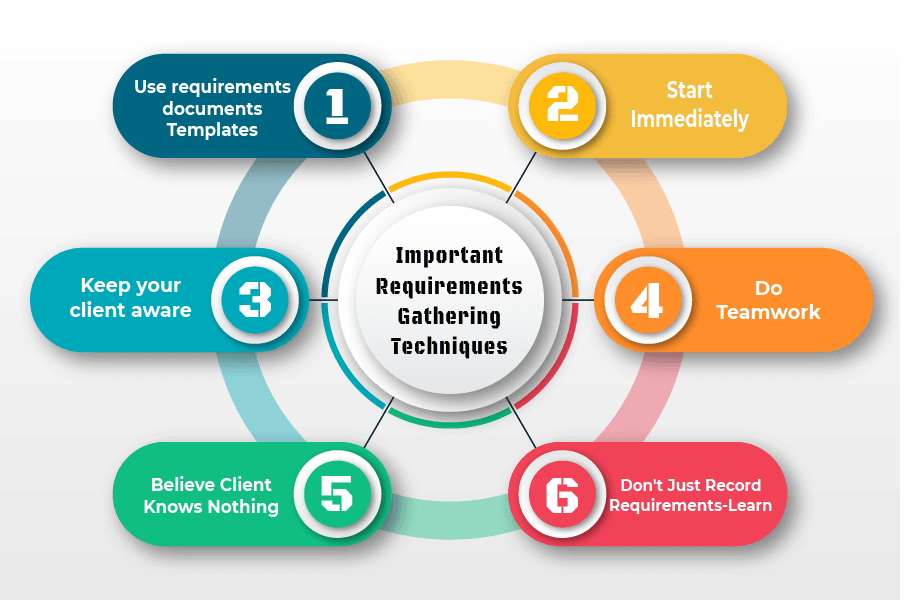The Importance of Requirements Gathering for a Business Analyst
Requirements gathering is one of the most critical phases in the life cycle of a software development project. A business analyst (BA) plays a key role in this process, as they are responsible for understanding the needs of the business and translating those into actionable specifications for the development team. In fact, a well-conducted requirements gathering process can make the difference between the success and failure of a project.
What is Requirements Gathering?
At its core, requirements gathering refers to the process of collecting the necessary information about what a system, product, or solution must do in order to meet the needs of the stakeholders involved. This process involves gathering detailed information through communication with the client or end users to ensure the solution created aligns with their expectations and business objectives.
Business Analysts (BA) serve as the intermediaries between business stakeholders and technical teams, ensuring that all requirements are accurately captured and documented. A BA’s role in this process is not just to gather information but to clarify, validate, and document these requirements in a manner that is clear and understandable for the technical team to implement.
The Role of a Business Analyst in Requirements Gathering
The business analyst is responsible for conducting interviews, workshops, and surveys to collect the necessary requirements. These requirements can range from functional needs (such as a system feature) to non-functional needs (such as system performance). They may also cover business rules, system interfaces, user roles, and security needs.
The BA must ensure that the requirements gathered are SMART (Specific, Measurable, Achievable, Relevant, Time-bound). It is important that the BA is not just an information gatherer, but an active participant in shaping these requirements. This involves validating the accuracy of the information, managing stakeholder expectations, and balancing competing priorities.
Key Techniques for Effective Requirements Gathering

- Interviews: One-on-one discussions with stakeholders are a common method for gathering in-depth insights about business needs. These sessions can help uncover implicit requirements that stakeholders may not have considered.
- Workshops: Collaborative group settings can be useful for gathering diverse perspectives on a problem. Workshops allow stakeholders to brainstorm and refine requirements collectively.
- Surveys/Questionnaires: These tools are often used for collecting data from a larger group of users. They are particularly useful when trying to understand broad patterns and trends.
- Use Cases and User Stories: BAs often use use cases or user stories to gather detailed requirements about how the system should behave from an end-user perspective. These help to create a clear picture of what the system needs to do.
- Prototyping: In some cases, BAs use prototyping to visually demonstrate what a product or system will look like, allowing users to provide feedback before development begins.
Why is Requirements Gathering Critical?
- Clarity and Understanding: A successful requirements gathering process ensures that all stakeholders (both business and technical) are on the same page. This reduces ambiguity and misunderstandings about what the system is supposed to do.
- Cost Control: Correctly gathering the right requirements upfront ensures that the development team knows exactly what to build. This minimizes scope creep and helps avoid unnecessary costs.
- Quality Assurance: By identifying the requirements early, the BA ensures that the testing phase will have clear acceptance criteria. This results in better quality products that meet user expectations.
- Timely Delivery: Properly gathered requirements help the development team estimate project timelines more accurately. When the requirements are well-defined, the development cycle can proceed without unnecessary delays.
- Stakeholder Satisfaction: By engaging stakeholders early in the process and ensuring that their needs are met, a BA ensures that the end result will meet their expectations. This leads to higher stakeholder satisfaction and increases the likelihood of project success.
Common Challenges in Requirements Gathering
- Conflicting Requirements: Often, different stakeholders may have different views on what the system should achieve. The BA must mediate between conflicting interests to create a unified set of requirements.
- Unclear or Ambiguous Requirements: Stakeholders may not always have a clear understanding of what they need. A skilled BA must ask probing questions and clarify vague or incomplete requirements.
- Changing Requirements: As the project progresses, requirements may evolve. The BA must be flexible and agile in adapting to these changes while maintaining control over scope creep.
- Stakeholder Engagement: Engaging stakeholders in the requirements gathering process can be difficult, especially when they are busy or lack clarity on their needs. A BA needs strong communication and negotiation skills to overcome these challenges.
Key Skills for Business Analysts in Requirements Gathering
- Communication Skills: BAs need strong verbal and written communication skills to accurately capture and explain requirements.
- Analytical Thinking: The ability to break down complex problems and identify underlying issues is essential in understanding business needs.
- Problem-Solving: The BA must be able to identify solutions and work with stakeholders to refine the requirements in a way that is feasible and effective.
- Stakeholder Management: Building strong relationships with stakeholders is essential for getting accurate and complete information.
- Technical Acumen: A basic understanding of technology can be beneficial when discussing technical requirements with developers and engineers.
Tools and Technologies for Requirements Gathering

While traditional methods like interviews and workshops are still effective, there are various modern tools and technologies that BAs can leverage to improve the requirements gathering process.
- Jira and Confluence: These popular tools help track requirements, user stories, and bugs, allowing BAs to collaborate with technical teams.
- Microsoft Visio: Visio is often used for creating visual diagrams, such as process flows or data models, to support the documentation of requirements.
- Balsamiq and Axure: These prototyping tools help BAs create mockups or wireframes to visualize requirements for stakeholders.
- Trello: For simpler projects, Trello can help organize and track the status of requirements as they evolve.
Most of the time, business customers expect software teams to read their minds on what they want, and to deliver a solution based on unknown or unspoken requirements.
If as a business analyst, you are able to invest time in gathering and developing a clear, correct, correct, and measurable set of requirements, then you are certain to also develop software of high quality based on what the client needs.
Depending on the project methodology you choose to implement (whether Agile or Waterfall), requirement gathering for a business analyst typically takes place during the project initiation stage or discovery phase. A skilled business analyst will ensure requirement gathering for a business analyst is conducted throughout each sprint cycle to maintain clarity and alignment. If you are interested in learning business analysis in greater detail, you can enroll in this Business analysis online certification.
There are important guidelines and techniques involved in Requirements Gathering, but here are some of the importance.
Eliciting Project Requirements
Requirement gathering for a business analyst helps you in eliciting project activities from your client so that you can effectively deliver a full-fledged product that will meet all their specifications. This being the basis of any project to be delivered, this will help you and your project associates to communicate effectively and effortlessly over the needs of the client.
Increases the level of Satisfaction of Business Client
Requirements Gathering helps a business analyst to satisfy the needs of the client, but if it is not done correctly, then there is a high probability that the project deliverables (service or product) will not meet the business requirements, hence leaving the client to be left unsatisfied.
When issues are detected in regards to following the requirements properly, it can lead to an extension of the project deadlines which in turn leads to an increase in the working hours out by the development team. This will ultimately not only lead to wastage of time, but of money, and resources. That is why it is important that Requirements Gathering is properly carried out.
Provides Opportunity to generate Real Improvements to Business Operations

As a business analyst working in a large organization, business requirements provide you with the opportunity to generate real improvements to business operations with clients. Most projects in large organizations arise from a response to some need or some current failing. A sizable amount of resources are then used to complete these projects. This means it is crucial that they deliver what was actually needed or it would have been a waste of time and money. A good business requirement gathering will help you as a business owner to avoid this situation by precisely defining the requirements needed to meet a specific objective.
Helpful in operating a Business Requirement Document (BRD)
This will also help you as a business analyst to utilize the information in preparing a Business Requirements Document (BRD). The Business Requirement Document is the foundation for all subsequent project deliverables because it fully describes what inputs and outputs are related to each process function.
The BRD includes documentation of customer needs and expectations which is essentially gotten from Requirements Gathering.
Conclusion
The success of any project as a business analyst largely depends on the thorough requirements gathering for a Business Analyst carried out at the beginning of the project. Without a clear understanding of what the stakeholders need, the project is likely to face delays, confusion, or even failure. Requirements gathering is not just about collecting information; it’s about building relationships with stakeholders, ensuring that their goals and expectations are met, and setting the foundation for the entire project lifecycle.
Key Takeaways for Effective Requirements Gathering
- Communication is Key: Clear communication with stakeholders is essential for understanding their needs.
- Stakeholder Engagement: Regular involvement of stakeholders throughout the process ensures the requirements are accurate and aligned with the business goals.
- Use of Tools and Techniques: Utilizing tools such as wireframes, prototypes, and surveys helps visualize requirements and gather accurate data.
By applying these principles, business analysts can create detailed, accurate requirements that set projects up for success.
Call to action
At H2K Infosys, we provide specialized business analyst training and placement services that equip you with the skills needed to succeed in the competitive world of business analysis. With our expert instructors and hands-on training, you’ll be well-prepared to gather, document, and communicate requirements like a pro.
Enroll today to advance your skills in business analysis and make a real impact in your projects and organization. You can learn more about requirement elicitation by enrolling in an Online business analyst training.




























